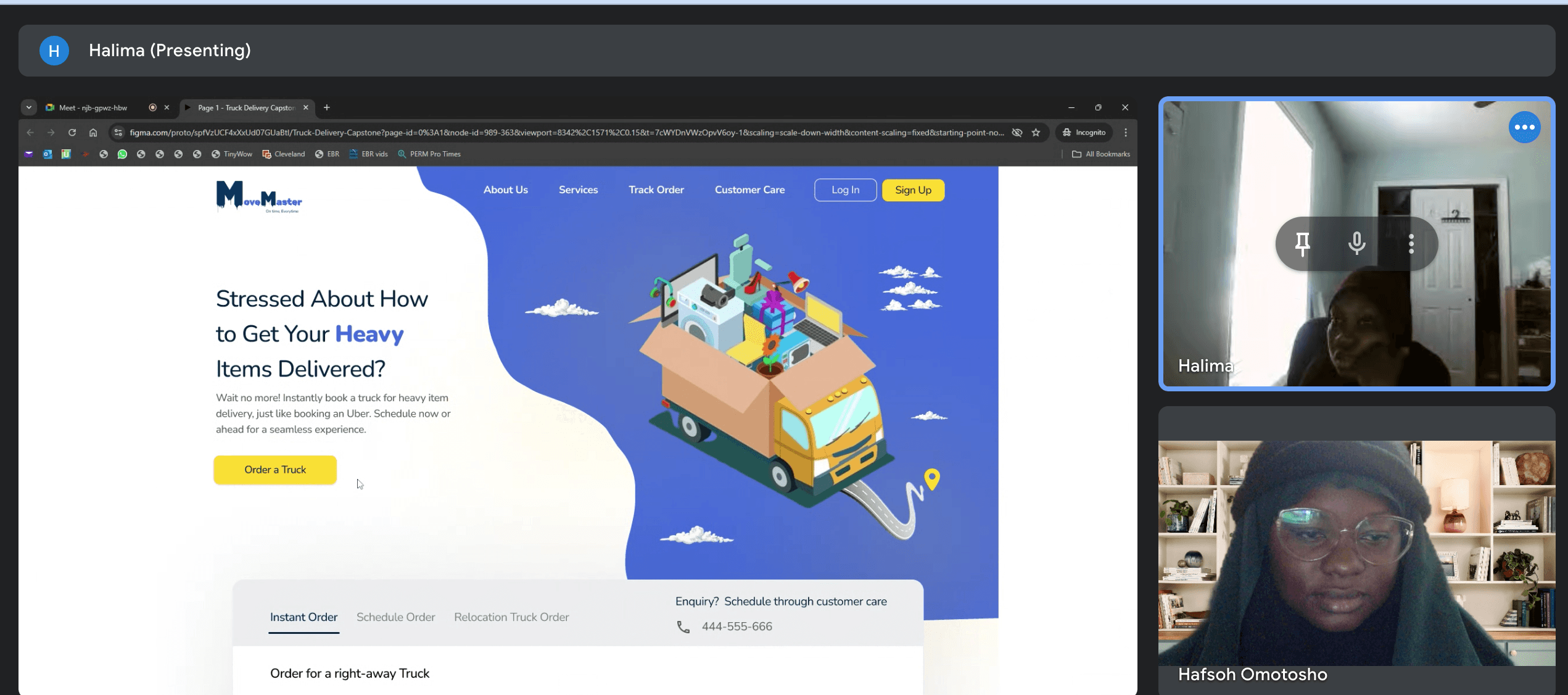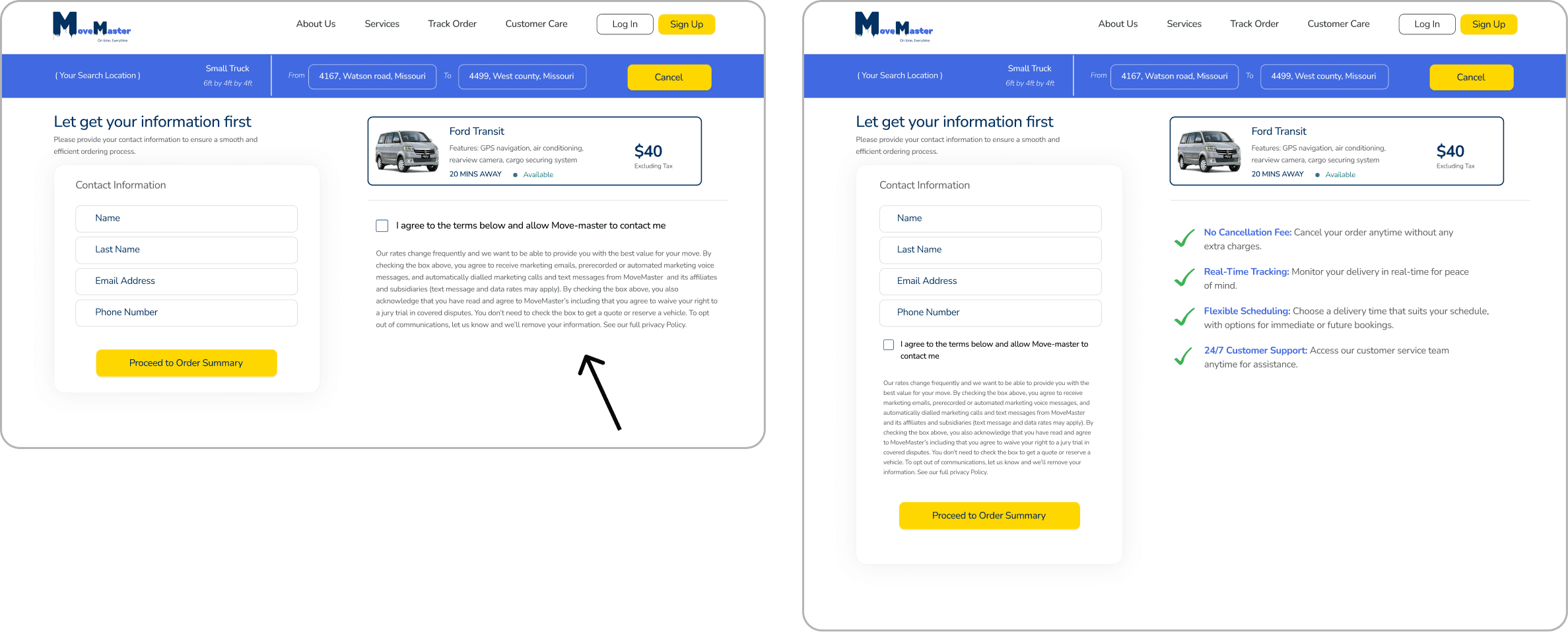ve
aster
M
On time, Everytime
M

Macbook Pro
MoveMaster highlights the development of a streamlined haulage solution designed to simplify complex and time-consuming relocations, allowing for the instant transport of heavy items with ease and efficiency.
Year
Role
Project Type
Duration
2024
UX Designer, Research and UI Development
End to end Responsive design
1 Month

Solution
Move Master tackles the common challenges of heavy item transportation with a comprehensive and user-friendly haulage solution. Here’s how Move Master makes the relocation process seamless:
Move Master provides instant access to delivery trucks, enabling quick transport of heavy items like furniture from the store to your home, just like calling for uber you can call on move master as well to book a delivery ride.
The platform includes real-time tracking, allowing users to monitor their delivery every step of the way.
Move Master also provides 24/7 customer support, ensuring prompt assistance and maintaining high service standards.
SOLUTIONS OFFERED BY MOVE MASTER
Problem
Background
Relocating heavy items, especially after furniture shopping, is often a daunting task due to the lack of immediate delivery options. Shoppers frequently face the inconvenience of not having access to a truck or delivery service that can instantly transport their purchases home.
Traditional haulage solutions are complex, inefficient, and time-consuming, causing frustration, delays, and increased costs. There is a clear need for a streamlined approach that simplifies the logistics of moving bulky items, providing a quick and hassle-free experience for users.
CHALLENGE OVERVIEW
Before moving to the US, my family and I faced a significant challenge: transferring all our
belongings and properties to our hometown. Our visas were ready, and we had a specific time
frame to arrive in the US. However, we couldn't find any resources or transportation
companies to help us move our items. As a result, we were forced to sell our belongings at
cheaper and ridiculous prices because leaving them in our rented apartment was not an option
due to our relocation.
Another situation occurred shortly after we arrived in the US. While still trying to settle
down, I had the opportunity to take some disposal items from work, such as sofas and other
furniture, that were still neat and clean. The catch was that I needed to pick them up the same
day, or they would be disposed of. Unfortunately, there was no emergency or same-day
delivery van or truck available to help me in that situation, and I ended up losing the furniture
to disposal.
These experiences highlighted a critical gap in the market for reliable, on-demand delivery
haul services.
Research Approach
The frequency and nature of large item transportation needs.
The current methods and services used for transporting large items and their shortcomings.
Key factors that influence the choice of transportation services.
User preferences for service features and delivery options.
RESEARCH OBJECTIVES
The research aims to gather detailed insights into:
RESEARCH METHODOLOGY
TARGET AUDIENCE
The below methodologies will be applied in my research process.
The target users for the truck delivery service are:
Comparative and competitive research to see what our competitors offer and at what price points.
Surveys to allow collect data on various areas of concern from a large pool of people, such as customer satisfaction, product preferences, or market trends.
User interviews to hear from users firsthand their stories of how they use the service and what role it plays in their (work) lives. These can be part of, or in place of, contextual interviews depending on circumstances.
Individuals Relocating: People who are moving and need to transport their belongings, including furniture and other large items, either locally or to a different city.
New Arrivals: People who have recently moved to a new area and need to acquire or transport large items, such as furniture, quickly.
Small Businesses: Business owners who need to transport goods, supplies, or equipment regularly or on short notice.
Event Planners: Individuals or companies organizing events that require quick transportation of large items such as decorations, equipment, or furniture.
ASSUMPTIONS & RISKS
I began to identify potential risks and assumptions that could impact the project's success. I envisioned scenarios where unforeseen challenges might arise, such as:
By addressing these assumptions and risks, I can refine the business model to ensure the successful launch and operation of the truck delivery service..
There is a significant market demand for flexible and immediate truck delivery services.
Users are willing to pay for convenience and reliability.
A well-designed booking system will attract a broad user base.
High competition from established delivery and moving companies.
Operational challenges in managing a fleet of trucks and ensuring availability.
Potential high costs of vehicle maintenance and insurance.
User trust and safety concerns during the transport process.


Assumption
Risks
User Questioning
USER INTERVIEW DEBRIEF
VALUABLE INSIGHTS DERIVED FROM THE INTERVIEW QUESTIONING
FINAL PAIN-POINTS
Due to the limited number of candidates available for interviews, I decided to focus on
conducting a survey alongside moderated interviews. While I was able to interview 3
participants, I also gathered 25 responses from the survey.
I organised user responses into themes, identifying key issues and priorities and then further clustered similar feedback.
After clustering similar responses, I finalized the common themes identified among users. This process helped to clarify key concerns and priorities, guiding the development of targeted solutions to address these needs effectively.
From the 25 survey responses and the 3 in-depth interviews, I gathered detailed
insights into the challenges users face when transporting heavy items or moving to a
new place. These insights highlight the pain points and specific needs that must be
addressed to enhance the user experience on our delivery website
Difficulty Finding Suitable Vehicles: Many users struggle to find appropriate vehicles for transporting heavy items, often relying on hiring services, company vehicles, or waiting for available options.
High Cost of Transportation: Users frequently encounter high transportation costs, sometimes paying much more than expected to secure suitable help.
Finding Reliable Help: Trustworthy and reliable assistance is hard to come by, with users often uncertain about the safety and reliability of the movers they find.
Time Constraints: Securing appropriate vehicles often takes a long time, leading to delays and frustrations for users who need quick solutions.
Fear of Theft or Damage: Concerns about theft or damage during transport are common, with users worried about the safety of their belongings.

Maket Research
COMPETITIVE ANALYSIS LANDSCAPE
USER STERIOTYPE
To gain market insights and understand what drives success in the existing delivery truck market, I conducted a competitive analysis focusing on key players and their service offerings. The analysis aimed to identify strengths, weaknesses, opportunities, and threats within the industry.
Based on the insights gathered from user research, I developed user personas to better understand the target audience's needs, behaviours, and challenges. The personas were crafted by identifying common patterns in user feedback, including their goals, frustrations, and preferences.


Prioritisation
LET EXPLORE THE POSIBILITY OF POV AND HMW PROBLEM STATEMENT
PROPOSED FEATURES SUGGESTION
As I delved deeper into the project, I began by crafting a compelling point of view (POV) that captured the essence of the problem I was trying to solve. This POV served as the foundation for my subsequent brainstorming sessions.
From this POV, I generated a series of "How Might We" questions to spark my creativity and explore potential solutions. These questions guided my ideation process and helped me focus on the core challenges faced by my target users.
After a rigorous ideation process, I carefully selected the features that I believed would most effectively address the identified pain points and provide a compelling solution.
Problem 1: Reliability and Timely Delivery
POV
HMW
Users who need to transport heavy items are often frustrated by unreliable and delayed delivery services, which erodes their trust and causes significant inconvenience.
How might we ensure reliable and timely delivery of heavy items to enhance user trust and satisfaction?
Problem 2: Affordability
POV
HMW
Users are often deterred by high and unpredictable costs when transporting heavy items, which limits their ability to use such services regularly.
How might we make our transportation service affordable without compromising on quality?
Problem 3: Real-Time Tracking
POV
HMW
Users want to be informed about the status of their delivery in real-time to feel secure and stay updated on their heavy items' whereabouts.
How might we leverage technology to provide real-time tracking and updates on deliveries?
Problem 4: Customer Support
POV
HMW
Users often struggle to get timely and effective support when issues arise during the transportation of heavy items, leading to dissatisfaction and potential loss of business.
How might we offer robust customer support to assist users with any issues or queries?


Information Architecture and Flows
MAPPING USER’S PATH: TREE TESTING ANALYSIS
UNDERSTANDING USER JOURNEY : USER FLOW ANALYSIS
This tree testing aimed to evaluate the navigation structure, specifically focusing on the ease with which users could find key information such as delivery services, pricing, support, and tracking their goods.
To optimise the experience, I conducted a thorough analysis of your user flow. By mapping out the steps you take to achieve your goals within the platform. This analysis has helped us refine our design and provide a more enjoyable user experience.
A total of 15 participants, representative of our target audience, were recruited to complete a series of tasks using the simplified navigation structure.
ANALYSIS
Task Performance
Observation: The majority of participants successfully navigated to the correct pricing information. However, some participants hesitated between different pricing options before selecting the correct one.
Observation: Half of the participants found the correct path easily, while the other half struggled with identifying the correct subcategory under "Delivery Services." This indicates a need for clearer labelling or a more intuitive structure.
Observation: While 10% of participants successfully located the "Track My Goods" section, the other found it difficult to navigate to this feature within their dashboard. Participants often confused "Track My Goods" with other account-related functions, suggesting that the tracking feature's placement or labelling might be unclear.
Task 1: Find Pricing Information for Heavy Item Delivery
Success Rate: 80%
Expected Path: Home > Pricing > Heavy Item Delivery Pricing
Task 2: Schedule a Delivery for Next Week
Success Rate: 80%
Expected Path: Home > Delivery Services > Scheduled Delivery
Task 3: Track Goods Currently in Transit
Success Rate: 10%
Expected Path: Home > My Account > Track My Goods


Lofi Testing And Iteration
TESTING THE 5 SECONDS RULE
I conducted usability testing on the low-fidelity prototype by implementing the 5-second rule, where users were shown the landing page for just five seconds and then asked to describe what they thought the project was about.
Why I chose the 5-Second Rule as Important:
First Impressions Matter: Ensuring that users get the right first impression is vital for retention and engagement.
Clarity of Communication: It helps determine if the design effectively communicates the key value proposition without causing confusion.
Immediate User Understanding: It checks if users can quickly grasp the project's purpose, which is crucial for user satisfaction and successful onboarding.
Questions Asked:
After looking at the above image for 5 seconds, what do you think this service is about?
Could you explain what you understand by the terms instant delivery, scheduled delivery, and relocation delivery?
Results:
I tested the 5-second rule on 10 participants. Some participants identified the project as a logistics company, while others correctly identified it as a delivery and moving company. This mixed feedback highlights the need for refinement in my messaging and design to better convey the project's purpose.
Identified Misconceptions: The test revealed that while some users correctly identified the project as a delivery and moving company, others thought it was a logistics company. This indicates a need to refine my messaging and design elements for better clarity.









Hi-Fidelity Design Mock Up
BRINGING VISUAL TO LIVE
Landing Page
I've created a visually appealing landing page that captures attention and provides comprehensive information about our delivery truck service.
By combining compelling visuals with essential details, I've designed a page that effectively engages users and encourages them to take action

Macbook Pro
Instant Booking of Truck Like Uber ( Flow )
The truck booking platform revolutionises the way user book and order a truck.
Similar to popular ride-hailing apps, my solution offers a seamless and user-friendly experience for requesting trucks, tracking deliveries, and making secure payments.

Macbook Pro
Challenge of Finding Suitable Truck For Your Load
I addressed the challenge of finding the right truck for user needs by developing an intelligent matching system that considers factors like load size, distance, and vehicle type.
The platform ensures user gets the perfect truck for your specific requirements.

Macbook Pro
Tracking Your Truck Ride / Schedule Bookings
With the advanced tracking system, user can monitor the progress of their delivery in real-time.
User will experience the peace of mind that comes with knowing how their items are being delivered safely and efficiently.

Macbook Pro
RESPONSIVE MOBILE SCREENS

Final Usability Testing
BETA TESTING EVALUATION
TESTING PROCESS
SUMMARISED COMMON PAIN POINTS FROM THE TESTING
I conducted usability testing on our product with five individuals to gain insights into the user experience and identify areas for improvement for the haulage moving truck project. This debrief summarises the process, findings, and key takeaways from the testing sessions.
I selected five participants who represent my target audience for this usability testing. Each participant was asked to complete a series of tasks while using / navigating the website.
I observed their interactions, noted any challenges they faced, and gathered their feedback. The primary goal was to assess the overall usability and intuitiveness of the interface, as well as to identify any pain points or areas of confusion.
Navigation
Some navigations are not clickable, when user scroll to the footer, they wanted to continue from there but they are not clickable.
Terms & Condition
The terms and conditions agreement was not easily noticeable due to its placement in the far right corner of the page.
Clarity in Words
The home/ dashboard page after sign up, the book delivery was confusing as they were expecting to see order a truck or book a truck.
Clarifying Manpower Costs
The pricing information for manpower was unclear. It was not specified whether the quoted price of $20 per hour applied to individual workers or the entire team.
Back Button Placement
Users were confused by the placement of the back button in the top right corner. They instinctively searched for it in the top left.
Reducing necessary Steps
Certain tasks within the application involved more steps than users expected, potentially leading to frustration or confusion.

Iteration
CORRECTIONS BASED ON USABILITY FEEDBACK
After conducting usability testing and gathering feedback, several iterations were made to improve the Delivery Truck Project. These iterations were designed to address key areas of concern and enhance the overall system's efficiency and user experience. The updates were made where necessary.
The terms and conditions agreement not easily noticeable due to its placement in the far right corner of the page.
Users were confused by the placement of the back button in the top right corner. They instinctively searched for it in the top left.
Users were confused when trying to book a truck. They expected a clear "Book a Truck" option but instead found a "Book Delivery" option, which was misleading.
Before
Before
Before
After
After
After



Key Take Away
Lessons Learnt From This Project
User-Centered Design: The importance of actively listening, asking probing questions, and empathising with your target audience to gain a deep understanding of their needs and preferences."
Clear Communication: The value of providing clear and concise information throughout the booking process, from pricing to terms and conditions.
Navigating User Expectations: The Importance of Consistent Design
I learned the importance of adhering to familiar user interface conventions. Deviating from standard placements, such as the back button in the top left corner, can create confusion and hinder user navigation.
Final Prototype



